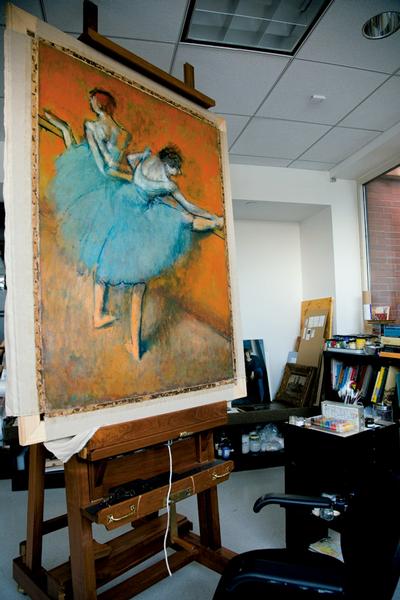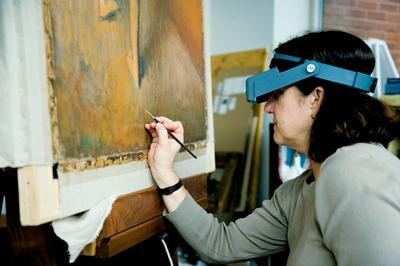Edgar Degas died in his Paris studio on September 27, 1917. His walls were hung with paintings he had worked on again and again, seeking perfection. The great artist was losing his eyesight, yet he stroked and daubed until the end.
“The fact is,” Degas told his friend the art dealer Ambroise Vollard, “I never feel really satisfied in letting any of my work go out of the studio.”
One of the paintings in his studio when he died showed two dancers stretching at the barre. One dancer leans to her right, reaches toward her toe, and wraps her hand around her ankle. The other leans back, her arm folded behind her, her ankle on the barre. Their turquoise skirts blend together against an orange background.
After his death, Degas’s relatives cleared the gallery and sold the works, including “Dancers at the Bar.” It went to Vollard, who sold it to another Parisian dealer, Jacques Seligmann. In 1921 he sold it to Joseph Widener, who sold it the same year to Kitty Harriman, then the wife of business magnate and later diplomat W. Averell Harriman.
Duncan Phillips bought “Dancers at the Bar” on February 18, 1944, for $18,000, which he paid in two installments, according to a copy of the original letter of sale. This Degas fit into Phillips’s growing collection of modern art housed in the family’s mansion at 21st and P streets near Dupont Circle.
Now “Dancers at the Bar” is one of the premier works in the Phillips Collection, along with Renoir’s “The Luncheon of the Boating Party” and treasures by Paul Gauguin, Vincent van Gogh, Thomas Eakins, Georgia O’Keeffe, Jacob Lawrence, and more. “Dancers” could be worth as much as $25 million at auction. “It is one of the collection’s great pieces,” says Phillips chief curator Eliza Rathbone.
But the masterpiece was aging badly.
Elizabeth Steele, head of conservation at the Phillips, first saw “Dancers at the Bar” 20 years ago, early in her career in art restoration.
“I was overwhelmed by the bold color schemes and how strained the poses are,” says Steele, whose friends call her Lilli. “You feel the dancers stretching and contorting their bodies.”
But Steele also saw the effects of time on the canvas and the colors. Viewers saw elegant forms and contrasting tones; the conservator saw the yellowing of aging varnish, flaking paint, and a heavy accumulation of airborne grime.
“Cracks are okay,” says Steele, “as long as paint isn’t starting to lift off the canvas.”
It was.

Steele bided her time. She became the Phillips Collection’s conservator in 1989, responsible for making sure its masterpieces were safe and sound. Every time she passed the Degas, she noticed its flaws. She detected a tiny tear in the canvas. She began building the case for taking it off the wall and into rehab. Last spring, she prevailed.
“It took me almost 20 years to have the confidence that I understood the picture,” she says. “I felt ready to work on it. And when I did, so many secrets unfolded.”
Conservators are artists, but they are also detectives and doctors. They have to sleuth out a painting’s provenance, diagnose its problems, then heal them.
“The original work has these secrets that are revealed only when it comes to conservation,” says Eliza Rathbone.
Here’s what Steele wondered when the painting was brought to her skylit studio in the Phillips Collection’s attic:
When did Degas paint “Dancers at the Bar”? Scholars disagreed. The 1880s? The early 1900s?
Degas often painted over his first attempts. Would “Dancers” reveal a hidden work?
What colors did Degas use? The painting had been covered at least once by varnish. What lay beneath?
While “Dancers” was on tour in 2006 to museums in New York and Chicago, Steele studied. She gathered Degas books. She wanted to get into the master’s head, study his style, his strokes, his paints.
“One of the privileges of my job is that I can take the time to get close to the artist, to almost become the artist,” she says. “I have to be able to understand what he wanted to do with each brush stroke.”
Is she putting herself in the position of repainting the original?
“Just the opposite,” she says. “I study the artist because I don’t want to affect his brush work. I don’t take risks. I don’t touch the painting if I don’t know the outcome of the conservation treatment.”
First, do no harm.
To get to Lilli Steele’s lair, we take an elevator from the ground floor of the original Phillips mansion up four flights, then take a windowed walkway to the top of the Goh Annex, which was added in 1989. Afternoon sun flows through skylights onto white surfaces in her studio.
“I work best in natural light,” she says. “That’s what Degas used.”
Tools that would look at home in a surgeon’s office are arranged on shelves and in rolling cabinets of drawers. There are cotton swabs and sticks, tweezers and scalpels, forceps and dental probes.
“Dancers at the Bar” is on an easel, no frame, naked on a stretcher. It seems larger than it did on the museum wall. It measures about four feet by three feet. The oranges and blues seem brighter—Steele has been working on the canvas for six months.
“Dancers at the Bar” returned to the Phillips from its tour in May 2007. Still in its crate, it was taken to Steele’s studio. Art handlers extracted it from the crate. Steele removed the frame. She spent the next month examining every square inch under a microscope mounted on a stand so it could be moved along the canvas.
“I can see worlds under the scope,” she says. “I can get lost.”
She saw spots on a dancer’s elbows where varnish had disfigured the paint. She saw folds of a tutu where paint was cracking and lifting from the canvas. She saw a thumbprint on a dancer’s neck. “With the original work covered by varnish, it looks like a heavy daub of paint or a smudge,” says Steele. “Then I realized he used his thumb like a brush to manipulate the paint. The white was too thick, so he thumbed it.”
Some secrets could be revealed only with an infrared camera, which allowed Steele to see through layers of paint.
Like many artists, Degas would paint over images, tinker with his subjects, change colors.
“How many times did he rework the composition?” Steele wondered.
Answer: many. “There were ghost images of different sets of arms and legs,” she says.
She pulls out a digital image made with the infrared camera. “He lowered this leg. Here’s a leg that doesn’t exist anymore.”
Paintings are often varnished when they are about to be sold, which has the immediate effect of brightening the original, making it seem more vibrant. But the effect over time is to dull the colors and turn them yellow.
“Degas would never have varnished this picture,” Steele says. “Someone much further down the road applied the varnish.”
The work of art restoration begins with cleaning tests. Steele had to find a solvent that would safely remove the varnish added after “Dancers” left Degas’s studio but not dissolve the paints.
Under the microscope, using a cotton swab rolled on a toothpick, she tested her solvent on every color on the canvas. Once she was sure it would take off only the varnish, she began to clean the painting a square inch at a time.
“It’s the riskiest thing you do to a painting,” she says. “If you dwell too long, the paint can become soluble. Too little time and you don’t bring out the true colors.
“You need a consistent hand—you have to get a rhythm going and keep moving.”
She worked four sessions, each half a day. As she rolled the swab, the varnish on the walls of the dance studio began to turn from muted yellow to vibrant orange.
“The colors started to jump off the canvas,” Steele says. “The dancers’ skirts turned from a gray to a robin’s-egg blue.”
Gray backs turned white. The dancers seemed to emerge from a fog. Now they stretched against an electric orange background.
When did Edgar Degas paint this work of art?
Born to a Parisian banker in 1834, Degas turned his room into a studio when he was a teenager and never stopped painting. He copied paintings at the Louvre, traveled to Italy in 1856, fought in the Franco-Prussian War in 1870, spent time visiting relatives in Louisiana. He returned to Paris in 1873 to paint in the milieu of the Impressionists—Vincent van Gogh, Edouard Manet, Paul Cézanne.
His eyes began to fail him, but Degas kept painting and sculpting until 1910. Most experts have guessed that he painted “Dancers at the Bar” around 1900.
“I wondered if we would be able to find a more precise date,” says Steele.
After cleaning the canvas, she took it off the stretcher Degas used about a century earlier, whose pinholes matched those in the canvas exactly. Written on the wooden stretcher in clear script was the date 1884 and an address in Paris. “This was the message in the bottle,” Steele says.
Steele discovered that the edges of the canvas had been cut and glued to another piece of canvas at the time paint was first applied. “Degas cut this picture down,” she says. “He probably cut it to crop the composition and put the dancers off center.”
Steele attached a fresh canvas backing to the original edges of the Degas. Then she assessed the cracks and tears in the surface of the paint and plotted a course for saving the masterpiece.
As “Dancers” lies flat on the table, Steele runs her hands lightly over the surface to feel the ridges and the cracks.

“You have to be able to touch it to work on it,” she says. “A brain surgeon has to lay hands on her patient. Me, too.”
Steele is in the midst of “consolidation,” the conservator’s term for gluing down lifted cracked paint that threatens to peel off the canvas. Degas’s work is propped on wooden blocks about ten inches above the table. Steele positions a small contraption under a spot where she sees paint lifting off.
Polish inventor Wieslaw Mitka invented this machine in the late 1980s to help conservators repair paintings. Placed under the canvas, it gently heats the paint and applies suction to pull the cracked paint down.
Steele places the device under a dancer’s arm. She adjusts the height and heat and turns on the suction. Then she dips a tiny sable brush into a small cup of isinglass, a pure white gelatin glue made from the air bladders of sturgeon. She runs the tip of the brush along the edge of each crack. The glue disappears in the crack; the paint adheres to the canvas.
“You don’t want it to be flat as a pancake,” she says. “You want it to be as flat as possible without flattening the surface texture. It’s a judgment call.”
She shifts the contraption under a dancer’s leg, dips the brush into the isinglass, and runs it along the edge of another crack.
Steele was born in Nashville. She became interested in art restoration while studying international relations in London.
“I spent a lot of time in museums, and I took art classes on the side,” she says. “Then I met an art restorer named Nelly Münthe who lived down the street. I became infatuated with what she did.
“I loved the material, the brushes, and working with my hands, but I didn’t want to be an artist—and I loved the science.”
She earned a degree in international relations but went on to study art history. She took courses in chemistry and physics. She returned to America and apprenticed for three years in a conservation firm in Nashville. She got a master’s degree from the State University of New York at Oneonta. She interned at the National Gallery of Art, then won a two-year fellowship at the Metropolitan Museum of Art in New York. In 1986 she came back to Washington and began working on art at the Phillips as a consultant. She joined the staff in 1989 and became head of conservation in 2002.
A few weeks later, “Dancers at the Bar” is once again upright on an easel. Consolidation is complete. She is ready to repaint the places that have been torn or scratched during 90 years of sales and travels and exhibitions.
The colors of the painting look much brighter than the last time I saw it.
“I thought I was finished cleaning it,” Steele says, “but when I went back to tidy it up, I discovered a whole new layer of dust and varnish.”
So she applied the solvents again, one square inch at a time. “It got a lot brighter,” she says. The dark lines along the dancers’ legs and skirts now are a brilliant Prussian blue; the orange background is almost aflame around the dancers’ heads.
All of this was preparation for retouching. “The really fun part,” she says.
The most significant tear is a two-inch gash in the paint on the lower right corner of the canvas, which depicts the floor of the dance studio. It looks like a thin caterpillar with a small head on its left end. The gash goes down to the bare canvas. Steele has applied a putty filling, made in Italy, to fill in the gap.
“Kind of like filling a tooth,” she says.
Now it’s time to channel Degas—to paint on his canvas and make the “worm” disappear into the floor. In real life the floor might have been a monochrome of dark brown wood, but Degas used at least four or five colors to give the floor depth. I see green, turquoise, jade, maroon, rose.
Did he start with purple and add cadmium? Was his pigment vermillion or earth red? The Impressionists of Degas’s day were beneficiaries of the Industrial Revolution, which broadened their palette with manmade colors. Cobalt violet, one of Degas’s favorites, was introduced in 1859.
“My best guess is that Degas used purple in the underpainting,” Steele says.
She surveys her palette: 50 tiny plastic cups filled with powdered pigments. She scoops out some grains of cobalt violet. Making a medium of vinyl acetate, ethanol, and diacetone alcohol, she mixes it into a liquid paint and applies it in dabs to the slit. In minutes the worm is purple.
Just as quickly, the afternoon sun fades, and light leaves her studio. “Done for the day,” she says.
We have to wait a week before storms pass through Washington, clouds leave the sky over the Phillips, and sun pours through the four windows in the ceiling of Steele’s studio.
She sends me an e-mail at 10:41: “Am starting now. Come on over.”
I find Steele peering at the floor of “Dancers” through magnifying loupes attached to a headpiece. The purple is gone. She has mixed chrome yellow with cadmium red on a small white ceramic tile she uses as a final palette. She picks up paint with a tiny sable brush and applies it to the canvas with light brush strokes, some quick daubs, some curving strokes.
“I try to weave it together like a puzzle,” she says. “Degas used so many colors, it’s easy to hide your tracks. So far, I have been hitting it.”
One paint stroke stands out.
“That’s probably too red,” she says. “Better to start brighter and take it down a notch.” “Scrumbling” it’s called.
By noon the major tear has disappeared. Steele moves on to scratches near one dancer’s leg.
“My retouching is pretty much complete,” she says.
To finish her restoration of “Dancers at the Bar,” Steele applied a coat of matte varnish to protect the painting without making it glossy.
On January 10, Lilli Steele hung “Dancers at the Bar” in the West Parlor of the Phillips Collection, confident that it looked almost exactly as it did when it left Edgar Degas’s studio 90 years ago.


















